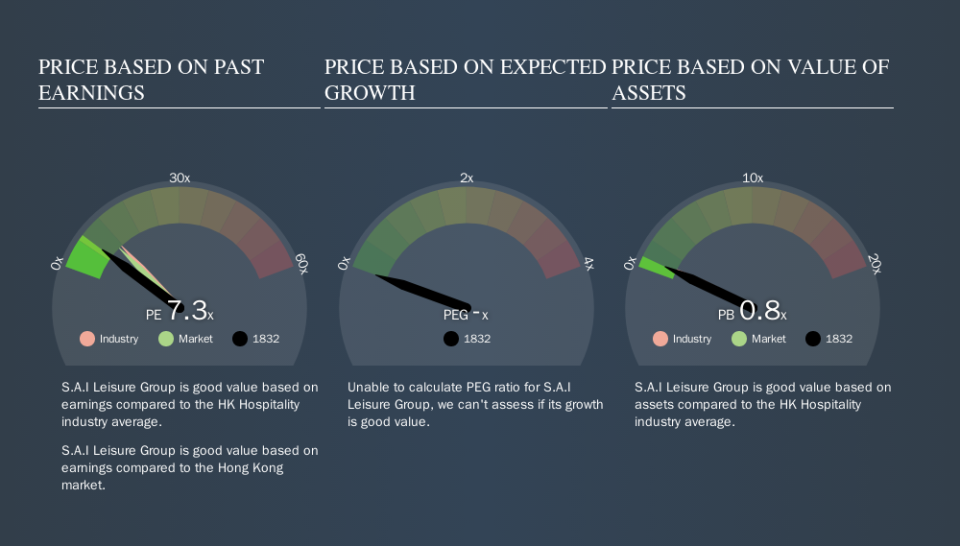Is S.A.I Leisure Group Company Limited's (HKG:1832) P/E Ratio Really That Good?

This article is for investors who would like to improve their understanding of price to earnings ratios (P/E ratios). We'll apply a basic P/E ratio analysis to S.A.I Leisure Group Company Limited's (HKG:1832), to help you decide if the stock is worth further research. Looking at earnings over the last twelve months, S.A.I Leisure Group has a P/E ratio of 7.31. That means that at current prices, buyers pay HK$7.31 for every HK$1 in trailing yearly profits.
View our latest analysis for S.A.I Leisure Group
How Do I Calculate A Price To Earnings Ratio?
The formula for price to earnings is:
Price to Earnings Ratio = Price per Share (in the reporting currency) ÷ Earnings per Share (EPS)
Or for S.A.I Leisure Group:
P/E of 7.31 = $0.26 (Note: this is the share price in the reporting currency, namely, USD ) ÷ $0.036 (Based on the year to June 2019.)
Is A High Price-to-Earnings Ratio Good?
A higher P/E ratio implies that investors pay a higher price for the earning power of the business. All else being equal, it's better to pay a low price -- but as Warren Buffett said, 'It's far better to buy a wonderful company at a fair price than a fair company at a wonderful price.'
How Does S.A.I Leisure Group's P/E Ratio Compare To Its Peers?
The P/E ratio essentially measures market expectations of a company. We can see in the image below that the average P/E (11.6) for companies in the hospitality industry is higher than S.A.I Leisure Group's P/E.
This suggests that market participants think S.A.I Leisure Group will underperform other companies in its industry. Many investors like to buy stocks when the market is pessimistic about their prospects. You should delve deeper. I like to check if company insiders have been buying or selling.
How Growth Rates Impact P/E Ratios
Probably the most important factor in determining what P/E a company trades on is the earnings growth. That's because companies that grow earnings per share quickly will rapidly increase the 'E' in the equation. Therefore, even if you pay a high multiple of earnings now, that multiple will become lower in the future. Then, a lower P/E should attract more buyers, pushing the share price up.
S.A.I Leisure Group saw earnings per share decrease by 29% last year.
Remember: P/E Ratios Don't Consider The Balance Sheet
It's important to note that the P/E ratio considers the market capitalization, not the enterprise value. Thus, the metric does not reflect cash or debt held by the company. In theory, a company can lower its future P/E ratio by using cash or debt to invest in growth.
Spending on growth might be good or bad a few years later, but the point is that the P/E ratio does not account for the option (or lack thereof).
How Does S.A.I Leisure Group's Debt Impact Its P/E Ratio?
With net cash of US$49m, S.A.I Leisure Group has a very strong balance sheet, which may be important for its business. Having said that, at 52% of its market capitalization the cash hoard would contribute towards a higher P/E ratio.
The Verdict On S.A.I Leisure Group's P/E Ratio
S.A.I Leisure Group trades on a P/E ratio of 7.3, which is below the HK market average of 10.7. The recent drop in earnings per share would almost certainly temper expectations, but the net cash position means the company has time to improve: if so, the low P/E could be an opportunity.
When the market is wrong about a stock, it gives savvy investors an opportunity. As value investor Benjamin Graham famously said, 'In the short run, the market is a voting machine but in the long run, it is a weighing machine.' We don't have analyst forecasts, but shareholders might want to examine this detailed historical graph of earnings, revenue and cash flow.
Of course, you might find a fantastic investment by looking at a few good candidates. So take a peek at this free list of companies with modest (or no) debt, trading on a P/E below 20.
We aim to bring you long-term focused research analysis driven by fundamental data. Note that our analysis may not factor in the latest price-sensitive company announcements or qualitative material.
If you spot an error that warrants correction, please contact the editor at editorial-team@simplywallst.com. This article by Simply Wall St is general in nature. It does not constitute a recommendation to buy or sell any stock, and does not take account of your objectives, or your financial situation. Simply Wall St has no position in the stocks mentioned. Thank you for reading.


